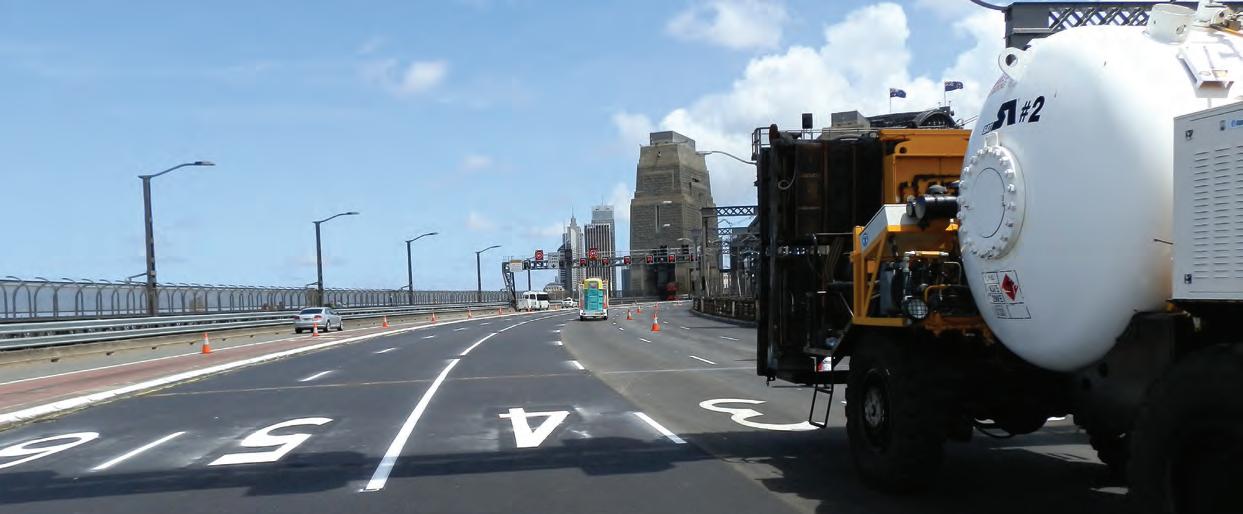
4 minute read
Edge protection
EARLY PLANNING FOR EDGE PROTECTION
AN INNOVATIVE SOLUTION FOR HANDRAIL INSTALLATION KNOWN AS NON-DRILL IS HELPING MAJOR PROJECTS INCREASE ON-SITE PRODUCTIVITY AND SAFETY.
Planning for handrail installation while designing a precast concrete infrastructure project can save time, money and reduce risk. With planning ahead, at the design phase, contractors can ensure the quality of products needed for construction projects isn’t compromised.
It is these factors NON-DRILL founder Paul Breen considered when he created the company’s innovative handrail system for precast and in-situ concrete, used in temporary and permanent handrails.
The NON-DRILL system attaches to the existing precast lifting anchors using its patented clutch which simply hooks onto the anchor. The post is then tightened securely into place by hand.
A system such as this, when specified during the design phase, can then be simply prepared during pre-construction. This eliminates the need for workers to define measurements at the time of installation, saving time and labour costs.
NON-DRILL also has in-house install crews that can come out to site and install the system to further save the crew’s time.
Campbell McNiven, former Senior Project Engineer and now Contracts Manager with Specialist Tunnel Excavation, says NONDRILL has the potential to simplify work on infrastructure projects.
He says that using existing precast lifting anchors to save time is incomparable to the upfront costs, time and risks involved with drilling. “The integrity and design life of the structures we create is of great importance. It, therefore, makes sense to avoid destructive drilling works in a finished product,” Mr. McNiven says.
“By removing the need to drill, you remove high-risk activities from handrail installation as well as preserve the quality of the permanent structure.”
He says NON-DRILL ticks the boxes for quick deployment, short- or long-term use, no temporary works and no damage or repairs to concrete.
“When I see concrete being drilled, typically for edge protection installations, I think how much easier, safer and costeffective it would be if the NON-DRILL system was planned for when the concrete was poured. It makes sense in so many applications. Some forward thinking is all that is needed,” Mr. McNiven says.
Mr. Breen says that from a labour standpoint, planning the spacing of anchors in the design phase enables workers to get straight to twisting the handrails into place. This can remove the risk of human error and

By taking away the need to drill, end users remove high-risk activities from handrail installation as well as preserving the quality of the permanent structure.
speed up the installation time.
He says 12 NON-DRILL posts can be installed in the time it takes to drill one typical post.
NON-DRILL can also be used as a solution to add additional lifting anchors to precast items for increased safety when loading and unloading trucks. For example, anchors could be added to Super-T girders, along the edges, which riggers can use as extra connection points.
Mr. Breen says one of NON-DRILL’s largest projects, in Melbourne, saw the contractor install over 30,000 anchors pre-set around the edges of their bridge segments.
“Later, when they install the bridge parapets, they can transfer them to the existing anchors on top of the bridges. This is a great example of planning ahead at the design stage and ensuring all edge protection meets the required standards,” he says.
Mr. Breen says NON-DRILL is now increasingly being used as a permanent handrail after contractors have applied it for a temporary protection system during construction.
NON-DRILL uses its modular connections to transfer between temporary and permanent handrails without exposing a live edge. Additionally, Mr. Breen says it also eliminates the need for welding, harnesses for fall protection and elevated work platforms, giving users a fully galvanised system.
He says if handrails are installed incorrectly this can open a project up to major safety risks.
“The same can be said when removing handrails. With traditional handrails, bolts need to be cut off and drilled out below the concrete before it is repaired, and this can often be done incorrectly,” Mr. Breen says.
“When removing the NON-DRILL system, the anchor is already below the surface. All that is required is to grout or epoxy over the anchor point with little risk of damage to concrete.”
If ever damaged, Mr. Breen says NONDRILL can easily be replaced. This means workers will not have to manage sheared bolts or have to drill in a new location.
There are more uses for the NONDRILL system than temporary and permanent handrails.
Mr. Breen says the connection itself is multipurpose. The anchors are certified for lifting and are therefore suitable for securing formwork props, scaffolding and almost anything that is typically drilled and secured in concrete.
Jaybro, a company that supplies gawk screens and signposts for Jersey barriers, offers NON-DRILL to its clients as another option to avoid drilling.
Ben Lorne, Business Development Manager at Jaybro, says the company was receiving enquiries for a simple solution to display signage on concrete barriers.
“Our current posts were side-mounted and not able to give the exposure required. But the NON-DRILL posts allow for a top connection with easy access and installation and no drilling required. It just makes sense for us to offer this to our clients,” Mr. Lorne says.
Mr. Breen says it gives the company great confidence that the industry is acknowledging the need to avoid drilling.
“We are seeing this in the volume of repeat orders and feedback from our clients.”
To find out more about NON-DRILL visit www.non-drill.com.au or call +61 409 541 384
1-2 September 2020 International Convention Centre Sydney

300 EXHIBITORS
280 SPEAKERS
5000 ATTENDEES
Want to be a part of Australia’s BIG trade expo for the entire roads transport ecosystem? Sponsor/Exhibit Get involved today! Register FREE Join us on LinkedIn











